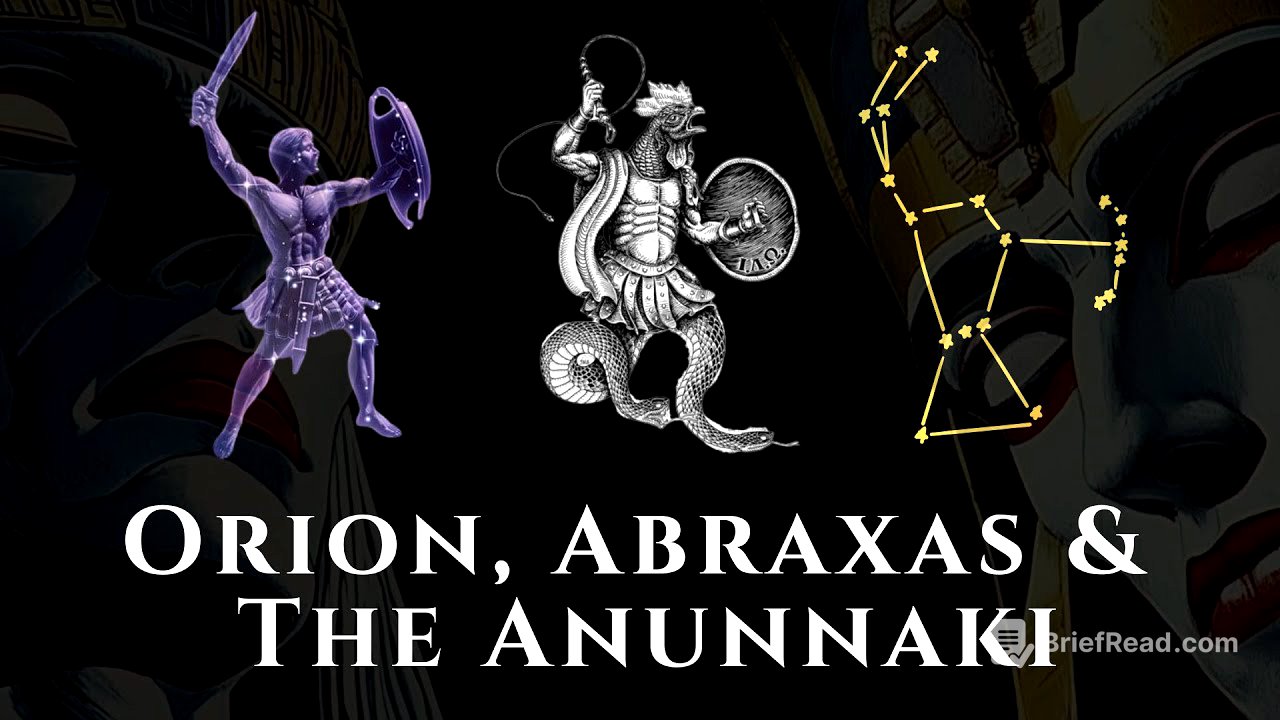TLDR;
This video explores the significance of the Orion constellation across various ancient cultures, examining its role in mythology, religion, and architecture. It suggests that Orion was not merely a pattern of stars but a key, a signpost left by those who came before us. The video touches on Sumerian, Egyptian, Greek, Norse, Hindu, and Gnostic interpretations of Orion, as well as its possible connection to the Anunnaki and the book of Enoch.
- Orion's consistent presence in diverse cultures suggests a shared, deeper meaning.
- Ancient structures like the pyramids of Giza and Teotihuacan align with Orion, indicating its importance in their cosmology.
- Orion may have been seen as a portal or gateway between the earthly and divine realms.
Intro [0:00]
The video introduces Orion as a constellation revered by ancient civilizations, serving as a guide, ruler, and god. It poses questions about why Orion appears in the myths of cultures that never met, why it's encoded in the layout of pyramids and temples, and what its true significance is, suggesting it might be a key or signpost left by those who came before.
The Oldest Constellation [2:32]
In Sumer, Orion, known as Uru Anna (the light of heaven), was a sign of kingship and divine power, seen as a celestial throne and a direct link to the gods' domain. The Epic of Gilgamesh reflects this, with Orion representing Gilgamesh in eternal struggle with Taurus, the bull. Some believe the Sumerian ruling class traced their lineage to beings from the heavens.
The Stars Of Orion [5:08]
Orion is a well-documented constellation defined by bright, massive stars. Betelgeuse, a red supergiant, and Rigel, a blue supergiant, mark Orion's shoulder and foot, respectively, with Betelgeuse nearing a supernova. Orion's belt, consisting of Alnitak, Alnilam, and Mintaka, has served as a navigational marker and spiritual symbol. The Orion Nebula, a star-forming region, lies beneath the belt.
Greek Myths [8:19]
In Greek mythology, Orion was a giant, a hunter, and a figure of great strength and misfortune, son of Poseidon. Myths include his pursuit of Merope, his blinding by King Oenopion, and his demise by a scorpion sent by Gaia. Zeus placed Orion and Scorpius in the stars, forever chasing each other across the sky.
Orion In The Bible [10:25]
Orion is mentioned in the Bible as "Kesil" in the Book of Job, where it's referenced as a creation of God, an unshakable force in the heavens. God challenges Job about loosening Orion's belt, and the prophet Amos mentions God as the maker of Orion.
Osiris [12:13]
To the Egyptians, Orion was Osiris, the god of resurrection, with his soul dwelling among its stars, ruling over the Duat. Pharaohs were linked to Horus in life and would become Osiris in death, joining Orion in the sky. Orion's 70-day disappearance and rebirth mirrored the embalming process and Osiris' time in the underworld.
The Pyramids [14:14]
The layout of the three great pyramids of Giza mirrors the pattern of Orion's belt, with Menkaure's pyramid slightly offset. The Great Pyramid's southern shaft points to Orion, suggesting it was designed to send the pharaoh's soul back to the gods. The pyramid may have been a structure to interact with energy fields, possibly for communication or travel between Earth and Orion. Teotihuacan in Mexico mirrors the same alignment. Nabta Playa, an ancient stone circle in Egypt, was built to align with Orion.
Norse Myths [18:12]
In Norse cultures, Orion's presence is less defined but possibly linked to the myth of Orwandil, whose frostbitten toe became a star, potentially Rigel. Orion may have been recognized as a hunter or warrior, similar to figures like Ullr, Tyr, and Thor. Vikings used Orion's belt for navigation.
Rudra Shiva [21:07]
In Hindu mythology, Orion is linked to Rudra, the god of storms and the great archer, later known as Shiva. Rudra is depicted as a hunter with a celestial bow, a force of destruction and rebirth, connected to Betelgeuse.
Azazel [22:45]
In the Book of Enoch, Azazel is a watcher who gave humanity knowledge of weapons, war, adornment, and cosmetics, leading to corruption. Orion, as the celestial hunter, mirrors Azazel's role in arming humanity. The story parallels Mesopotamian traditions of the Anunnaki and the god Enki, who brought knowledge but were later demonized.
Abraxas [25:55]
Abraxas, depicted on Gnostic amulets, is a being beyond gods and demons, representing totality. Basilides, a Gnostic teacher, described Abraxas as the ultimate divine being ruling over 365 heavens. Amulets depict Abraxas with a rooster or hawk head, a man's torso, and serpent legs, combining Egyptian, Greek, and Gnostic symbols. The name Abraxas in Greek isopsephy adds up to 365, mirroring the solar year. Abraxas and Orion seem to align, with Orion depicted as a figure in eternal battle.
The Anunnaki [31:41]
The Anunnaki, the gods of Sumer, shaped ancient civilizations, with their knowledge written in stone. The Sumerians aligned their sacred sites with celestial bodies, with Orion standing out as Uru Anna. Ancient kings claimed divine right as descendants of the gods, aligning themselves with Orion. Orion is seen as a portal or threshold between worlds, a bridge between higher and lower realms.
Credits [34:20]
Credits for the video.









